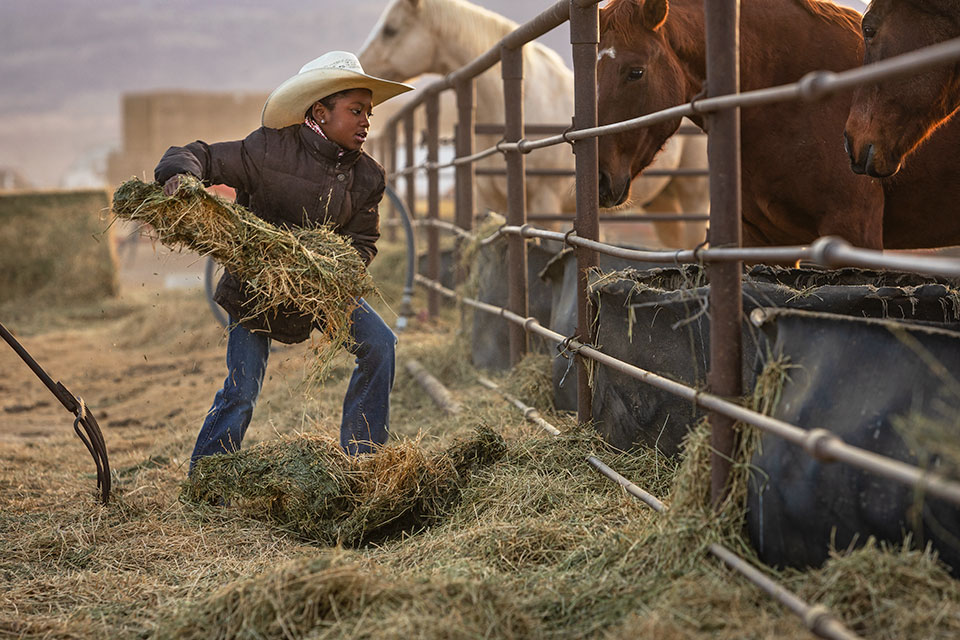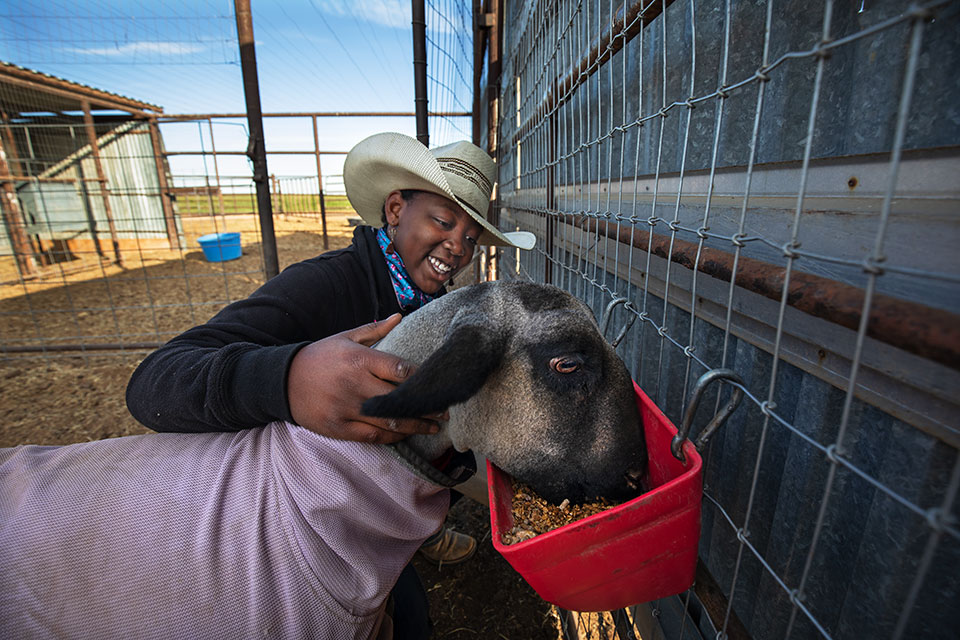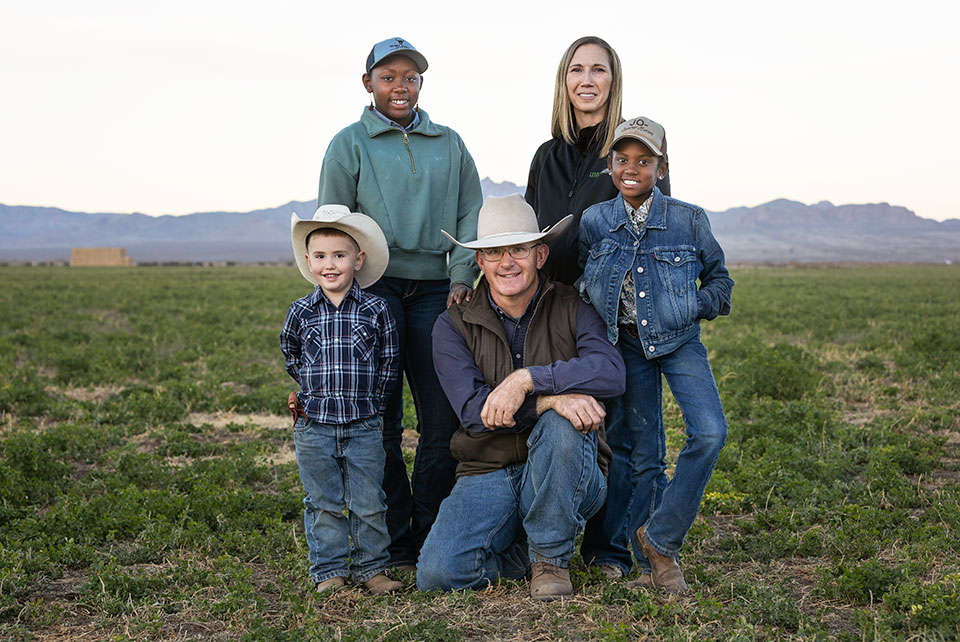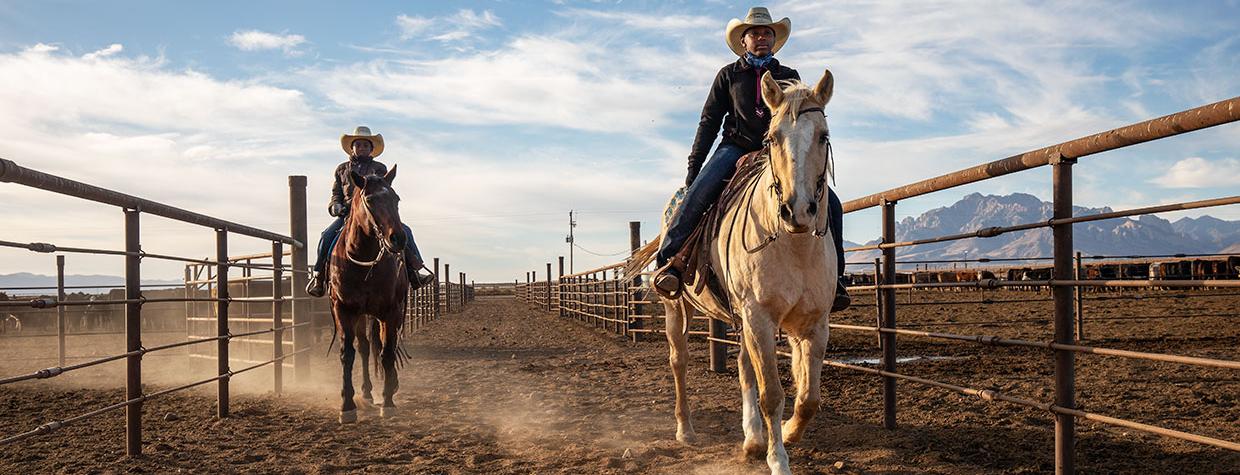WhiteBarn Hay & Cattle, near Portal, rests in the cradle of the San Simon Valley, the 65-mile-long swath of land that separates the Chiricahua, Dos Cabezas and Pinaleño mountains on its western edge from the Peloncillo Mountains on its east side. There, Candice and Jason Barnard raise cattle, including wagyu beef, and grow corn and other crops. They also home-school their three children — daughters Haidyn and Hannah, and son Ethan — and tend livestock guardian dogs, horses, show lambs and chickens.
It’s a traditional way of life for the Barnards, who both come from families with long farming and ranching legacies. Noel and Anna Curry settled in McNeal in 1952. The next year, Ernie and Eunice White moved from California and homesteaded just up the road, in the middle of a mesquite grove near Elfrida. The families became close friends, helping each other over the countless hurdles that emerge on the road to establishing crops and effectively working challenging land.

Jason, the Currys’ grandson, studied agronomy at Texas A&M University, while Candice, the Whites’ granddaughter, studied animal science at the University of Arizona. The couple met in Cochise in 2002 and married in 2004, joining the two families.
Now, the Barnards’ children are learning the family business, helping with feeding animals, working the crops and so much more. Here, Haidyn, 13, and Hannah, 12, share their thoughts about living and working at WhiteBarn:
What do you like about living on the farm?
Haidyn: My absolute favorite thing about living on the farm is the spectacular view of the mountains and the valley from our living room window. I love seeing my horses every day and picking fresh alfalfa for them. I also enjoy “farm talks” with my parents, when we talk about animal health care and the growing conditions on the farm.
Hannah: I love to smell the fresh-cut alfalfa as I run by the fields on my horse. It is also very fun to play with my lambs on the cotton mounds and piles of corn. Picking fresh corn from the field is amazing. Sometimes my dad and I find the best ear of corn to eat, and it’s always sweet, crisp and tasty!
What are some of the challenges of farm life? And how do you handle them?
Haidyn: Some “farm talk” sessions are about the challenges of farming. Diseases in crops can be a big challenge. This year, we grew corn that became infested with leafhoppers — green bugs that hop from corn leaf to corn leaf, eating sap from the leaves and transferring a virus into the plant. The virus stresses the plant and decreases the yield. The yield is very important to our family feedlot — we feed the corn we grow to the cattle that come to our feed yard. A lower yield means a higher cost in corn production and that we have to buy corn from other local corn producers.
Hannah: Drought is one of our biggest challenges on the farm and ranch. With no rain, we have to move the cattle into the higher pastures, where there’s a little more feed. When the feed runs out, we will have to make some tough management decisions because, without rain, the grass won’t last long. Little rainfall can be both good and bad for our crops. This year, we harvested seven cuts of alfalfa and had no rained-on hay! The bad part about no rain is that we had no help to water the crops, and the water bill gets really expensive.

Talk about the animals on the farm.
Haidyn: We have many animals on the farm. We definitely have a lot of cattle. We also have chickens, livestock guardian dogs, a lot of horses and occasionally some show lambs.
Hannah: We have many animals here on our farm and ranch. We have cattle, show lambs, chickens, horses, dogs and cats. There is always some kind of animal noise through all parts of the day and night.
Can the heavy equipment be intimidating,or is it kind of cool?
Haidyn: As I get older, working with heavy equipment gets more and more fun. From the ages of 3 to 5, riding on the tractor or playing with tractor tire rims was more fun than playing “mud pie factory” in our playhouse. One time, when I was about 6, my daddy took my sister and me with him on the swather to start cutting alfalfa. Inside, there were lots of tiny alfalfa spiders. I absolutely dislike spiders of any size, so I freaked out — screaming, crying, the whole tantrum of being afraid of little spiders. Daddy let me drive with him because there weren’t a great deal of spiders on the driver’s side. As we were turning around to start cutting another section, I turned the swather steering wheel a little too vigorously, and the swather spun around and around really fast! My sister and I thought it was the best ride in the whole world, but not so much my daddy ... so I didn’t get to drive anymore. At age 13, I enjoy driving the tractors, but I am still scared of the alfalfa spiders in the swather. When I’m around heavy equipment, I have to be very careful so I don’t get hurt.
Hannah: When I wake up in the morning, there’s always something rumbling around. Equipment is one of the most popular things you will see around here. We have tractors, balers, feed wagons and lots more. One of my favorite things about fall is when the corn chopper comes and chops the corn. It has lots of razor-sharp blades used to grind the corn and turn it into silage. Every morning, Lupe scoops up feed with the loader and puts it into the feed mixer wagon. Then he drives by the feed bunks and the mixer pours out pounds of feed for the cattle. The ranch always smells like fresh hay in the mornings.
What is it like to work at some of the markets where you sell your beef?
Haidyn: I love going to farmers markets to sell beef! I like to answer people’s questions and talk about our beef genetics. The hardest part of the market is getting everything ready. We have to clean the beef wagon, then pack all the cuts of beef and make sure we have all the selling supplies, such as the cash box, the table, the price sheet and other important things. After we get everything packed, we wash the beef wagon so it looks nice and flashy. The second-hardest part is driving to the market. We live far from town, and it takes several hours of driving. When we get there, we have to hurry and set up, because people are waiting for us to arrive. My siblings and I then set up quickly while our mom and dad talk to customers. It’s always fun to set up signs and arrange the table with price sheets and pictures of the cattle.
Hannah: Going to farmers markets is a great experience. I learn a lot about being a great saleswoman and how to communicate about what happens on our farm. But my favorite thing about the farmers markets is shopping. I love to support the other vendors who are selling. In fact, I have become so regular that when I walk around, the vendors know me by name. The farmers market is the place to go to have fun.

Growing up on a farm and ranch takes “farm fresh” to a whole new level. What are some of your favorite meals that center on the food you’ve grown?
Haidyn: My all-around favorite food is black bean and pumpkin chili [see page 49]. I would be OK if my mom made me this once a week for the rest of my life. Smoked brisket is another of my favorites — that’s always a special treat.
Hannah: I have a lot of favorite recipes, so this question is hard. But somehow I managed to narrow it down to three: I love chicken fried steak and mashed potatoes, enchiladas and rice, and black bean and pumpkin chili. These are my favorite foods to eat for breakfast, lunch, dinner and leftovers!
Black Bean and Pumpkin Chili
Ingredients:
- 3 pounds ground beef
- 1 medium yellow onion, chopped
- 1 medium sweet yellow pepper, chopped
- 3 garlic cloves, minced
- 2 cans (15 ounces each) black beans, rinsed and drained
- 1 can (15 ounces) solid-pack pumpkin
- 1 can (14.5 ounces) diced tomatoes
- 3 cups beef broth
- 2 teaspoons dried parsley flakes
- 2 teaspoons chili powder
- 1½ teaspoons dried oregano
- Salt, to taste
- Pepper, to taste
- Avocado, cubed (optional)
- Green onions, thinly sliced (optional)
Directions:
In a large skillet over medium heat, add the ground beef, onion and yellow pepper. Cook, stirring, until the ground beef is no longer pink. Add garlic and cook 1 minute longer. Transfer to a 5-quart slow cooker, then stir in the black beans, pumpkin, tomatoes, beef broth, parsley, chili powder, oregano, salt and pepper. Cook, covered, on low for 4 to 5 hours. If desired, top with avocado and green onions.
For more information about WhiteBarn Hay & Cattle, visit whitebarnwagyu.com.

